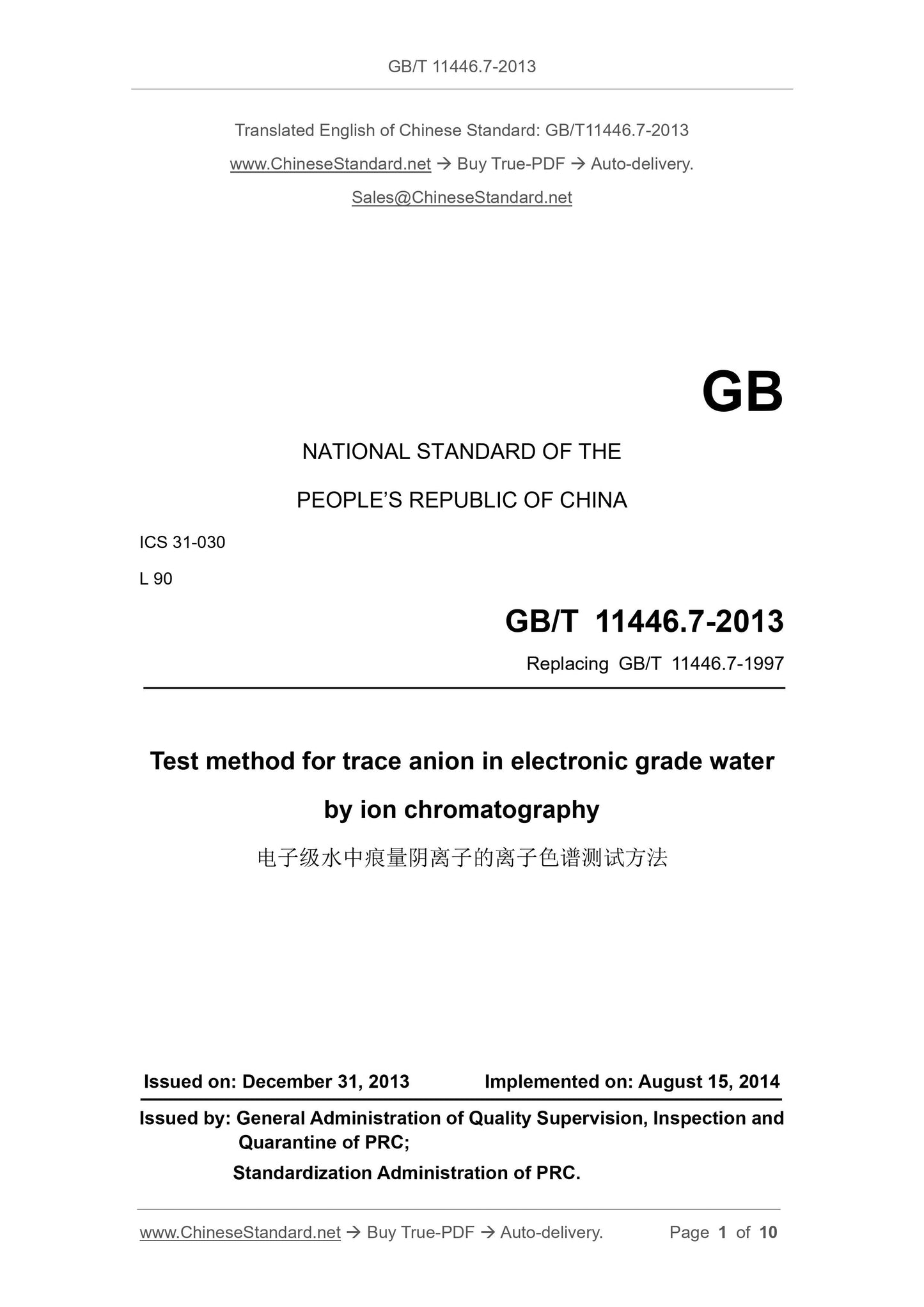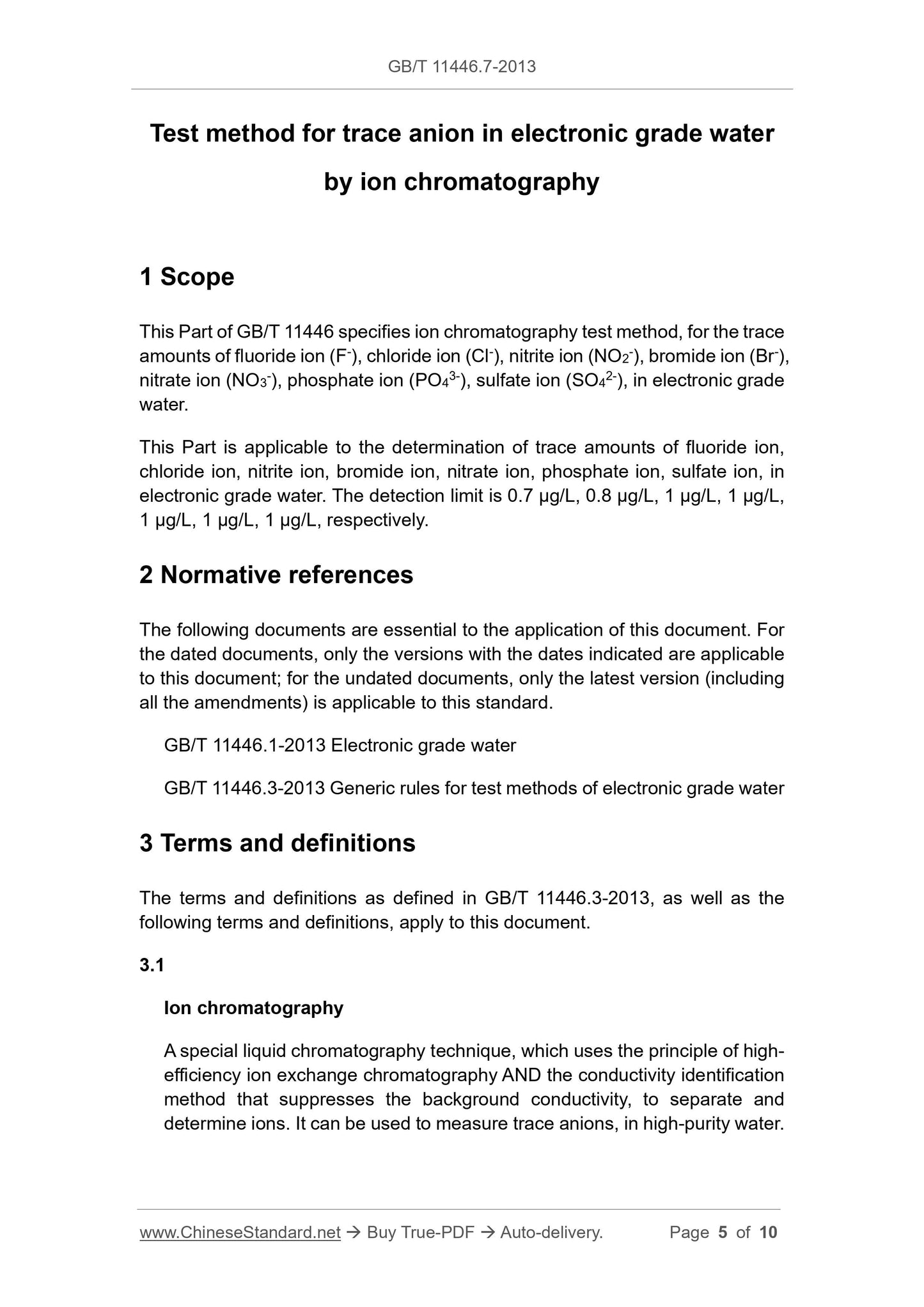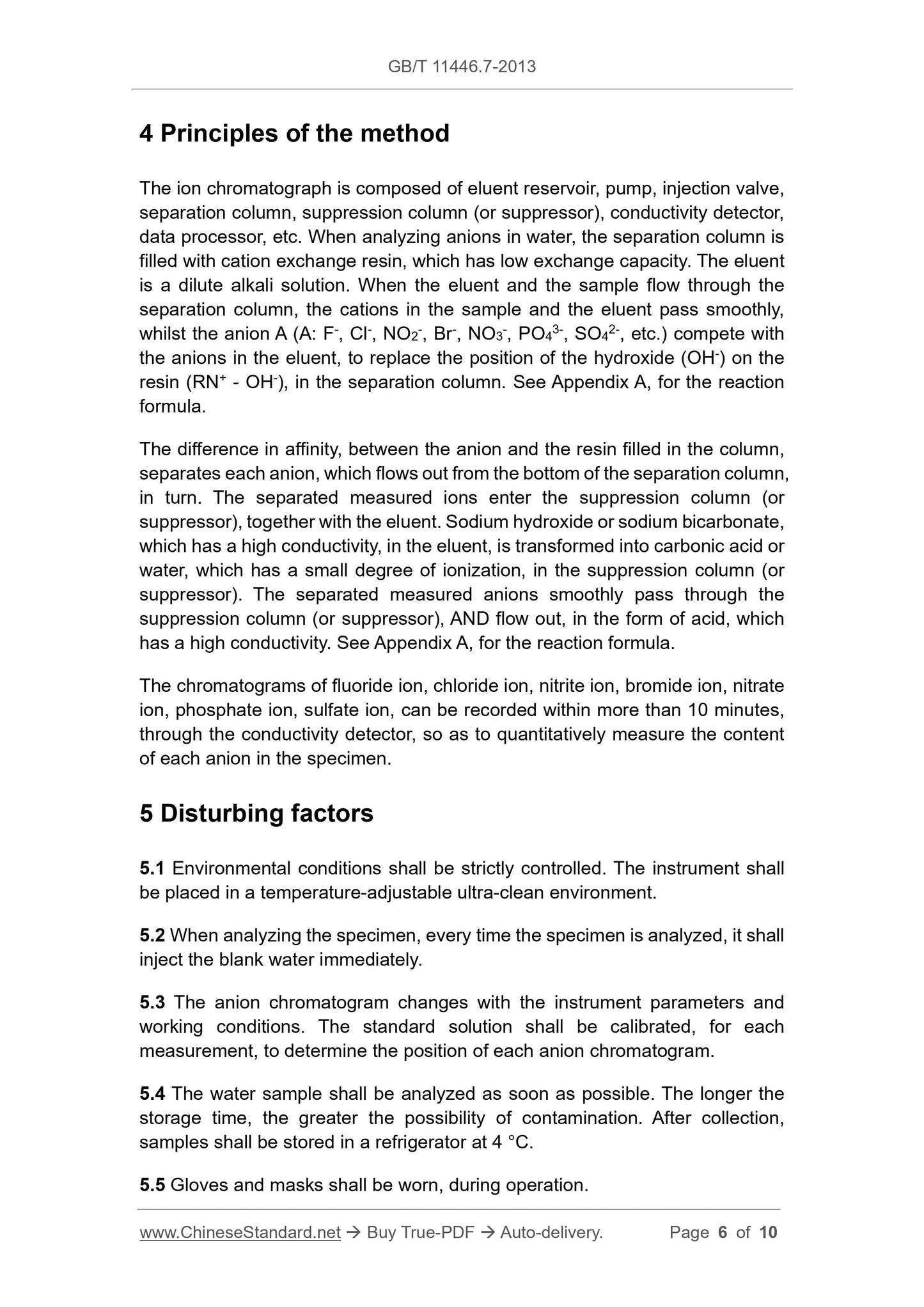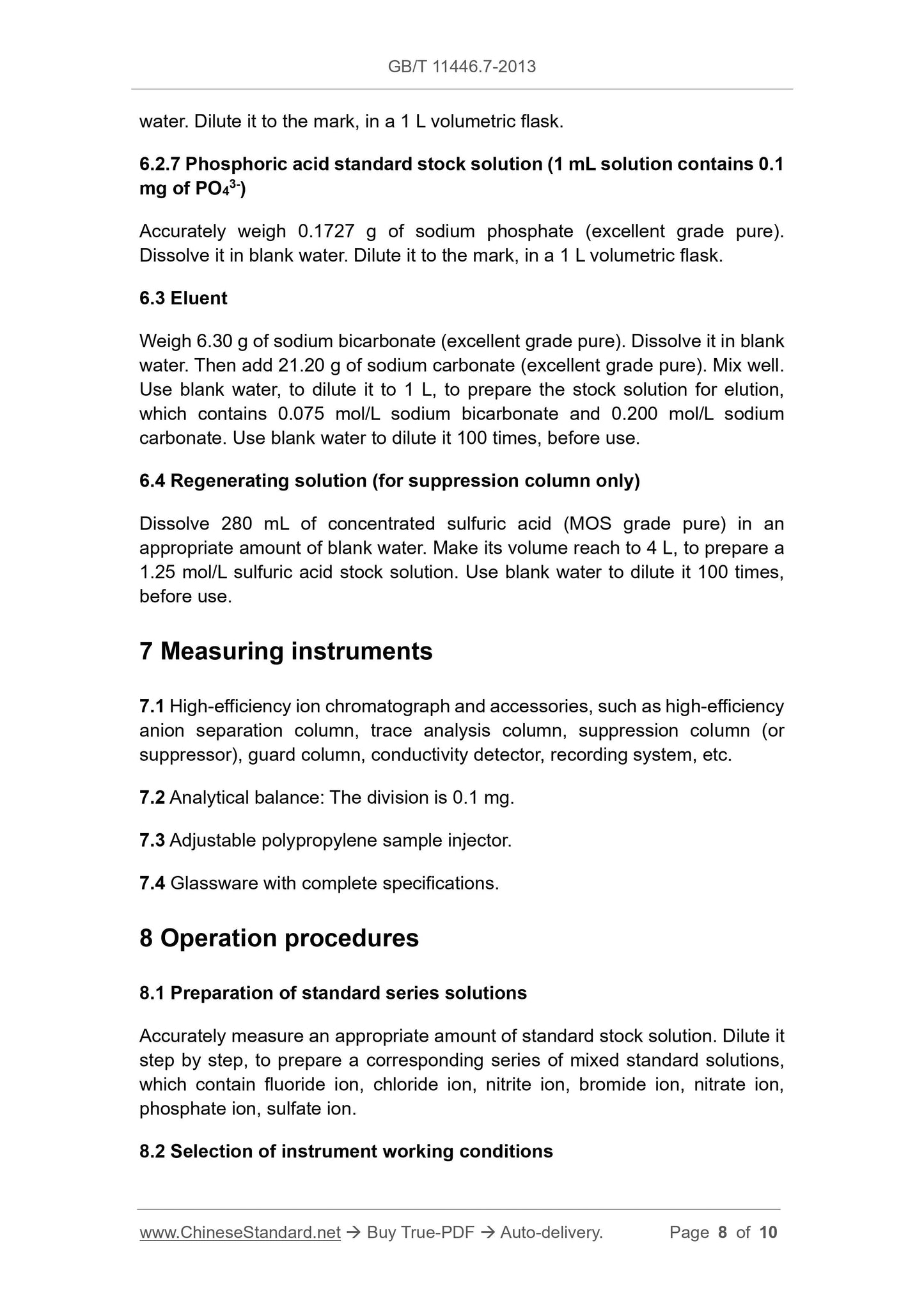1
/
of
5
PayPal, credit cards. Download editable-PDF and invoice in 1 second!
GB/T 11446.7-2013 English PDF (GBT11446.7-2013)
GB/T 11446.7-2013 English PDF (GBT11446.7-2013)
Regular price
$160.00 USD
Regular price
Sale price
$160.00 USD
Unit price
/
per
Shipping calculated at checkout.
Couldn't load pickup availability
Delivery: 3 seconds. Download true-PDF + Invoice.
Get QUOTATION in 1-minute: Click GB/T 11446.7-2013
Historical versions: GB/T 11446.7-2013
Preview True-PDF (Reload/Scroll if blank)
GB/T 11446.7-2013: Test method for trace anion in electronic grade water by ion chromatography
GB/T 11446.7-2013
GB
NATIONAL STANDARD OF THE
PEOPLE’S REPUBLIC OF CHINA
ICS 31-030
L 90
Replacing GB/T 11446.7-1997
Test method for trace anion in electronic grade water
by ion chromatography
ISSUED ON: DECEMBER 31, 2013
IMPLEMENTED ON: AUGUST 15, 2014
Issued by: General Administration of Quality Supervision, Inspection and
Quarantine of PRC;
Standardization Administration of PRC.
Table of Contents
Foreword ... 3
1 Scope ... 5
2 Normative references ... 5
3 Terms and definitions ... 5
4 Principles of the method ... 6
5 Disturbing factors ... 6
6 Reagents ... 7
7 Measuring instruments ... 8
8 Operation procedures ... 8
9 Precision ... 9
10 Report ... 9
Appendix A (Informative) Reaction of working principle of ion chromatography
... 10
Test method for trace anion in electronic grade water
by ion chromatography
1 Scope
This Part of GB/T 11446 specifies ion chromatography test method, for the trace
amounts of fluoride ion (F-), chloride ion (Cl-), nitrite ion (NO2-), bromide ion (Br-),
nitrate ion (NO3-), phosphate ion (PO43-), sulfate ion (SO42-), in electronic grade
water.
This Part is applicable to the determination of trace amounts of fluoride ion,
chloride ion, nitrite ion, bromide ion, nitrate ion, phosphate ion, sulfate ion, in
electronic grade water. The detection limit is 0.7 μg/L, 0.8 μg/L, 1 μg/L, 1 μg/L,
1 μg/L, 1 μg/L, 1 μg/L, respectively.
2 Normative references
The following documents are essential to the application of this document. For
the dated documents, only the versions with the dates indicated are applicable
to this document; for the undated documents, only the latest version (including
all the amendments) is applicable to this standard.
GB/T 11446.1-2013 Electronic grade water
GB/T 11446.3-2013 Generic rules for test methods of electronic grade water
3 Terms and definitions
The terms and definitions as defined in GB/T 11446.3-2013, as well as the
following terms and definitions, apply to this document.
3.1
Ion chromatography
A special liquid chromatography technique, which uses the principle of high-
efficiency ion exchange chromatography AND the conductivity identification
method that suppresses the background conductivity, to separate and
determine ions. It can be used to measure trace anions, in high-purity water.
4 Principles of the method
The ion chromatograph is composed of eluent reservoir, pump, injection valve,
separation column, suppression column (or suppressor), conductivity detector,
data processor, etc. When analyzing anions in water, the separation column is
filled with cation exchange resin, which has low exchange capacity. The eluent
is a dilute alkali solution. When the eluent and the sample flow through the
separation column, the cations in the sample and the eluent pass smoothly,
whilst the anion A (A: F-, Cl-, NO2-, Br-, NO3-, PO43-, SO42-, etc.) compete with
the anions in the eluent, to replace the position of the hydroxide (OH-) on the
resin (RN+ - OH-), in the separation column. See Appendix A, for the reaction
formula.
The difference in affinity, between the anion and the resin filled in the column,
separates each anion, which flows out from the bottom of the separation column,
in turn. The separated measured ions enter the suppression column (or
suppressor), together with the eluent. Sodium hydroxide or sodium bicarbonate,
which has a high conductivity, in the eluent, is transformed into carbonic acid or
water, which has a small degree of ionization, in the suppression column (or
suppressor). The separated measured anions smoothly pass through the
suppression column (or suppressor), AND flow out, in the form of acid, which
has a high conductivity. See Appendix A, for the reaction formula.
The chromatograms of fluoride ion, chloride ion, nitrite ion, bromide ion, nitrate
ion, phosphate ion, sulfate ion, can be recorded within more than 10 minutes,
through the conductivity detector, so as to quantitatively measure the content
of each anion in the specimen.
5 Disturbing factors
5.1 Environmental conditions shall be strictly controlled. The instrument shall
be placed in a temperature-adjustable ultra-clean environment.
5.2 When analyzing the specimen, every time the specimen is analyzed, it shall
inject the blank water immediately.
5.3 The anion chromatogram changes with the instrument parameters and
working conditions. The standard solution shall be calibrated, for each
measurement, to determine the position of each anion chromatogram.
5.4 The water sample shall be analyzed as soon as possible. The longer the
storage time, the greater the possibility of contamination. After collection,
samples shall be stored in a refrigerator at 4 °C.
5.5 Gloves and masks shall be worn, during operation.
water. Dilute it to the mark, in a 1 L volumetric flask.
6.2.7 Phosphoric acid standard stock solution (1 mL solution contains 0.1
mg of PO43-)
Accurately weigh 0.1727 g of sodium phosphate (excellent grade pure).
Dissolve it in blank water. Dilute it to the mark, in a 1 L volumetric flask.
6.3 Eluent
Weigh 6.30 g of sodium bicarbonate (excellent grade pure). Dissolve it in blank
water. Then add 21.20 g of sodium carbonate (excellent grade pure). Mix well.
Use blank water, to dilute it to 1 L, to prepare the stock solution for elution,
which contains 0.075 mol/L sodium bicarbonate and 0.200 mol/L sodium
carbonate. Use blank water to dilute it 100 times, before use.
6.4 Regenerating solution (for suppression column only)
Dissolve 280 mL of concentrated sulfuric acid (MOS grade pure) in an
appropriate amount of blank water. Make its volume reach to 4 L, to prepare a
1.25 mol/L sulfuric acid stock solution. Use blank water to dilute it 100 times,
before use.
7 Measuring instruments
7.1 High-efficiency ion chromatograph and accessories, such as high-efficiency
anion separation column, trace analysis column, suppression column (or
suppressor), guard column, conductivity detector, recording system, etc.
7.2 Analytical balance: The division is 0.1 mg.
7.3 Adjustable polypropylene sample injector.
7.4 Glassware with complete specifications.
8 Operation procedures
8.1 Preparation of standard series solutions
Accurately measure an appropriate amount of standard stock solution. Dilute it
step by step, to prepare a corresponding series of mixed standard solutions,
which contain fluoride ion, chloride ion, nitrite ion, bromide ion, nitrate ion,
phosphate ion, sulfate ion.
8.2 Selection of instrument working conditions
Get QUOTATION in 1-minute: Click GB/T 11446.7-2013
Historical versions: GB/T 11446.7-2013
Preview True-PDF (Reload/Scroll if blank)
GB/T 11446.7-2013: Test method for trace anion in electronic grade water by ion chromatography
GB/T 11446.7-2013
GB
NATIONAL STANDARD OF THE
PEOPLE’S REPUBLIC OF CHINA
ICS 31-030
L 90
Replacing GB/T 11446.7-1997
Test method for trace anion in electronic grade water
by ion chromatography
ISSUED ON: DECEMBER 31, 2013
IMPLEMENTED ON: AUGUST 15, 2014
Issued by: General Administration of Quality Supervision, Inspection and
Quarantine of PRC;
Standardization Administration of PRC.
Table of Contents
Foreword ... 3
1 Scope ... 5
2 Normative references ... 5
3 Terms and definitions ... 5
4 Principles of the method ... 6
5 Disturbing factors ... 6
6 Reagents ... 7
7 Measuring instruments ... 8
8 Operation procedures ... 8
9 Precision ... 9
10 Report ... 9
Appendix A (Informative) Reaction of working principle of ion chromatography
... 10
Test method for trace anion in electronic grade water
by ion chromatography
1 Scope
This Part of GB/T 11446 specifies ion chromatography test method, for the trace
amounts of fluoride ion (F-), chloride ion (Cl-), nitrite ion (NO2-), bromide ion (Br-),
nitrate ion (NO3-), phosphate ion (PO43-), sulfate ion (SO42-), in electronic grade
water.
This Part is applicable to the determination of trace amounts of fluoride ion,
chloride ion, nitrite ion, bromide ion, nitrate ion, phosphate ion, sulfate ion, in
electronic grade water. The detection limit is 0.7 μg/L, 0.8 μg/L, 1 μg/L, 1 μg/L,
1 μg/L, 1 μg/L, 1 μg/L, respectively.
2 Normative references
The following documents are essential to the application of this document. For
the dated documents, only the versions with the dates indicated are applicable
to this document; for the undated documents, only the latest version (including
all the amendments) is applicable to this standard.
GB/T 11446.1-2013 Electronic grade water
GB/T 11446.3-2013 Generic rules for test methods of electronic grade water
3 Terms and definitions
The terms and definitions as defined in GB/T 11446.3-2013, as well as the
following terms and definitions, apply to this document.
3.1
Ion chromatography
A special liquid chromatography technique, which uses the principle of high-
efficiency ion exchange chromatography AND the conductivity identification
method that suppresses the background conductivity, to separate and
determine ions. It can be used to measure trace anions, in high-purity water.
4 Principles of the method
The ion chromatograph is composed of eluent reservoir, pump, injection valve,
separation column, suppression column (or suppressor), conductivity detector,
data processor, etc. When analyzing anions in water, the separation column is
filled with cation exchange resin, which has low exchange capacity. The eluent
is a dilute alkali solution. When the eluent and the sample flow through the
separation column, the cations in the sample and the eluent pass smoothly,
whilst the anion A (A: F-, Cl-, NO2-, Br-, NO3-, PO43-, SO42-, etc.) compete with
the anions in the eluent, to replace the position of the hydroxide (OH-) on the
resin (RN+ - OH-), in the separation column. See Appendix A, for the reaction
formula.
The difference in affinity, between the anion and the resin filled in the column,
separates each anion, which flows out from the bottom of the separation column,
in turn. The separated measured ions enter the suppression column (or
suppressor), together with the eluent. Sodium hydroxide or sodium bicarbonate,
which has a high conductivity, in the eluent, is transformed into carbonic acid or
water, which has a small degree of ionization, in the suppression column (or
suppressor). The separated measured anions smoothly pass through the
suppression column (or suppressor), AND flow out, in the form of acid, which
has a high conductivity. See Appendix A, for the reaction formula.
The chromatograms of fluoride ion, chloride ion, nitrite ion, bromide ion, nitrate
ion, phosphate ion, sulfate ion, can be recorded within more than 10 minutes,
through the conductivity detector, so as to quantitatively measure the content
of each anion in the specimen.
5 Disturbing factors
5.1 Environmental conditions shall be strictly controlled. The instrument shall
be placed in a temperature-adjustable ultra-clean environment.
5.2 When analyzing the specimen, every time the specimen is analyzed, it shall
inject the blank water immediately.
5.3 The anion chromatogram changes with the instrument parameters and
working conditions. The standard solution shall be calibrated, for each
measurement, to determine the position of each anion chromatogram.
5.4 The water sample shall be analyzed as soon as possible. The longer the
storage time, the greater the possibility of contamination. After collection,
samples shall be stored in a refrigerator at 4 °C.
5.5 Gloves and masks shall be worn, during operation.
water. Dilute it to the mark, in a 1 L volumetric flask.
6.2.7 Phosphoric acid standard stock solution (1 mL solution contains 0.1
mg of PO43-)
Accurately weigh 0.1727 g of sodium phosphate (excellent grade pure).
Dissolve it in blank water. Dilute it to the mark, in a 1 L volumetric flask.
6.3 Eluent
Weigh 6.30 g of sodium bicarbonate (excellent grade pure). Dissolve it in blank
water. Then add 21.20 g of sodium carbonate (excellent grade pure). Mix well.
Use blank water, to dilute it to 1 L, to prepare the stock solution for elution,
which contains 0.075 mol/L sodium bicarbonate and 0.200 mol/L sodium
carbonate. Use blank water to dilute it 100 times, before use.
6.4 Regenerating solution (for suppression column only)
Dissolve 280 mL of concentrated sulfuric acid (MOS grade pure) in an
appropriate amount of blank water. Make its volume reach to 4 L, to prepare a
1.25 mol/L sulfuric acid stock solution. Use blank water to dilute it 100 times,
before use.
7 Measuring instruments
7.1 High-efficiency ion chromatograph and accessories, such as high-efficiency
anion separation column, trace analysis column, suppression column (or
suppressor), guard column, conductivity detector, recording system, etc.
7.2 Analytical balance: The division is 0.1 mg.
7.3 Adjustable polypropylene sample injector.
7.4 Glassware with complete specifications.
8 Operation procedures
8.1 Preparation of standard series solutions
Accurately measure an appropriate amount of standard stock solution. Dilute it
step by step, to prepare a corresponding series of mixed standard solutions,
which contain fluoride ion, chloride ion, nitrite ion, bromide ion, nitrate ion,
phosphate ion, sulfate ion.
8.2 Selection of instrument working conditions
Share










